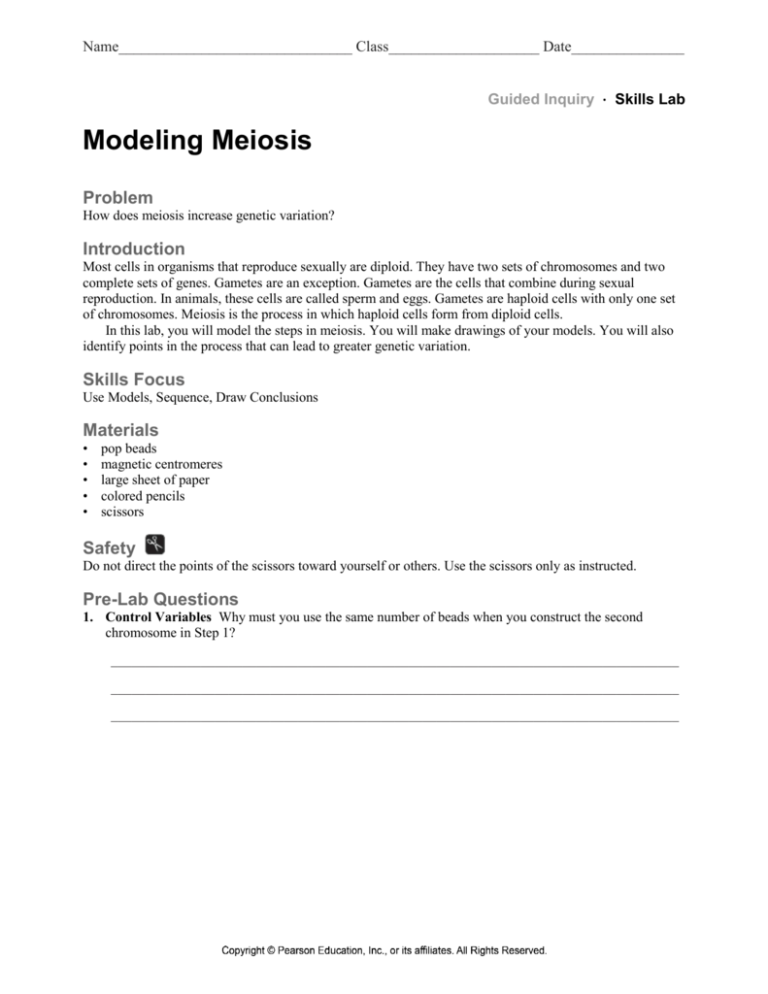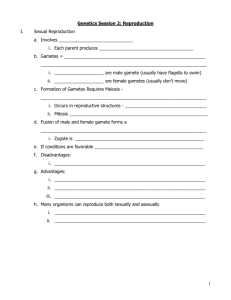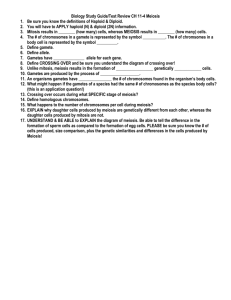Name_______________________________
advertisement

Name_______________________________ Class____________________ Date_______________ Guided Inquiry · Skills Lab Modeling Meiosis Problem How does meiosis increase genetic variation? Introduction Most cells in organisms that reproduce sexually are diploid. They have two sets of chromosomes and two complete sets of genes. Gametes are an exception. Gametes are the cells that combine during sexual reproduction. In animals, these cells are called sperm and eggs. Gametes are haploid cells with only one set of chromosomes. Meiosis is the process in which haploid cells form from diploid cells. In this lab, you will model the steps in meiosis. You will make drawings of your models. You will also identify points in the process that can lead to greater genetic variation. Skills Focus Use Models, Sequence, Draw Conclusions Materials • • • • • pop beads magnetic centromeres large sheet of paper colored pencils scissors Safety Do not direct the points of the scissors toward yourself or others. Use the scissors only as instructed. Pre-Lab Questions 1. Control Variables Why must you use the same number of beads when you construct the second chromosome in Step 1? __________________________________________________________________________________ __________________________________________________________________________________ __________________________________________________________________________________ Name_______________________________ Class____________________ Date_______________ 2. Infer Why is the longer chromosome pair used to model crossing-over? __________________________________________________________________________________ __________________________________________________________________________________ __________________________________________________________________________________ 3. Calculate A diploid cell has two pairs of homologous chromosomes. How many different combinations of chromosomes could there be in the gametes? __________________________________________________________________________________ __________________________________________________________________________________ Procedure The diploid cell in your model will have two pairs of homologous chromosomes. In order to keep track of the pairs, you will make one pair longer than the other. The beads will represent genes. Use the large sheet of paper to represent the cell. Part A: Interphase Just before meiosis begins, the chromosomes are replicated. 1. Use ten beads and a centromere of one color to construct the long chromosome. Use ten beads and a centromere of a second color to construct the second chromosome in the long pair. Make a drawing of the chromosomes in the space below. 2. For the second pair of chromosomes, use only five beads. Name_______________________________ Class____________________ Date_______________ 3. Now model the replication of the chromosomes. Make a drawing of your model in the space below. Part B: Meiosis I During meiosis I, the cell divides into two diploid daughter cells. 4. Pair up the chromosomes to form tetrads. Use the longer tetrad to model crossing-over. Make a drawing of the tetrads in the space below. Name_______________________________ Class____________________ Date_______________ 5. Line up the tetrads across the center of your “cell.” Then model what happens to the chromosomes during anaphase I. 6. Divide the cell into two daughter cells. Use the space below to make a drawing of the result. Part C: Meiosis II During meiosis II, the daughter cells divide again. 7. Line up the chromosomes at the center of the first cell, one above the other. Separate the chromatids in each chromosome and move them to opposite sides of the cell. 8. Repeat Step 7 for the second cell. 9. Divide each cell into two daughter cells. Use the space below to make a drawing of the four haploid cells. Name_______________________________ Class____________________ Date_______________ Analyze and Conclude 1. Relate Cause and Effect How does crossing-over increase variation in genes? __________________________________________________________________________________ __________________________________________________________________________________ __________________________________________________________________________________ 2. Use Models Suppose no crossing-over takes place. Use Step 5 to explain why meiosis will still increase genetic variation. __________________________________________________________________________________ __________________________________________________________________________________ __________________________________________________________________________________ __________________________________________________________________________________ 3. Compare and Contrast Compare your models of the four haploid cells with those of other groups. Describe and explain any variation that you observe. __________________________________________________________________________________ __________________________________________________________________________________ __________________________________________________________________________________ __________________________________________________________________________________ 4. Calculate What would happen to the possible variation in gametes if the number of chromosome pairs increased from two to three? What if the number increased again from three to four? __________________________________________________________________________________ __________________________________________________________________________________ __________________________________________________________________________________ __________________________________________________________________________________ 5. Apply Concepts How can independent assortment help explain genetic diversity in humans? Hint: How many pairs of chromosomes are in a human diploid cell? __________________________________________________________________________________ __________________________________________________________________________________ __________________________________________________________________________________ __________________________________________________________________________________ Name_______________________________ Class____________________ Date_______________ 6. Evaluate Models Suggest a way you could improve the models to better represent the process of meiosis. __________________________________________________________________________________ __________________________________________________________________________________ __________________________________________________________________________________ __________________________________________________________________________________ 7. Evaluate In terms of adaptation, what advantage does inherited variation during sexual reproduction provide for a species? __________________________________________________________________________________ __________________________________________________________________________________ __________________________________________________________________________________ __________________________________________________________________________________ __________________________________________________________________________________ Extend Your Inquiry Join with another group to model how genetic variation will increase during fertilization. Make a drawing of your model in the space below.








